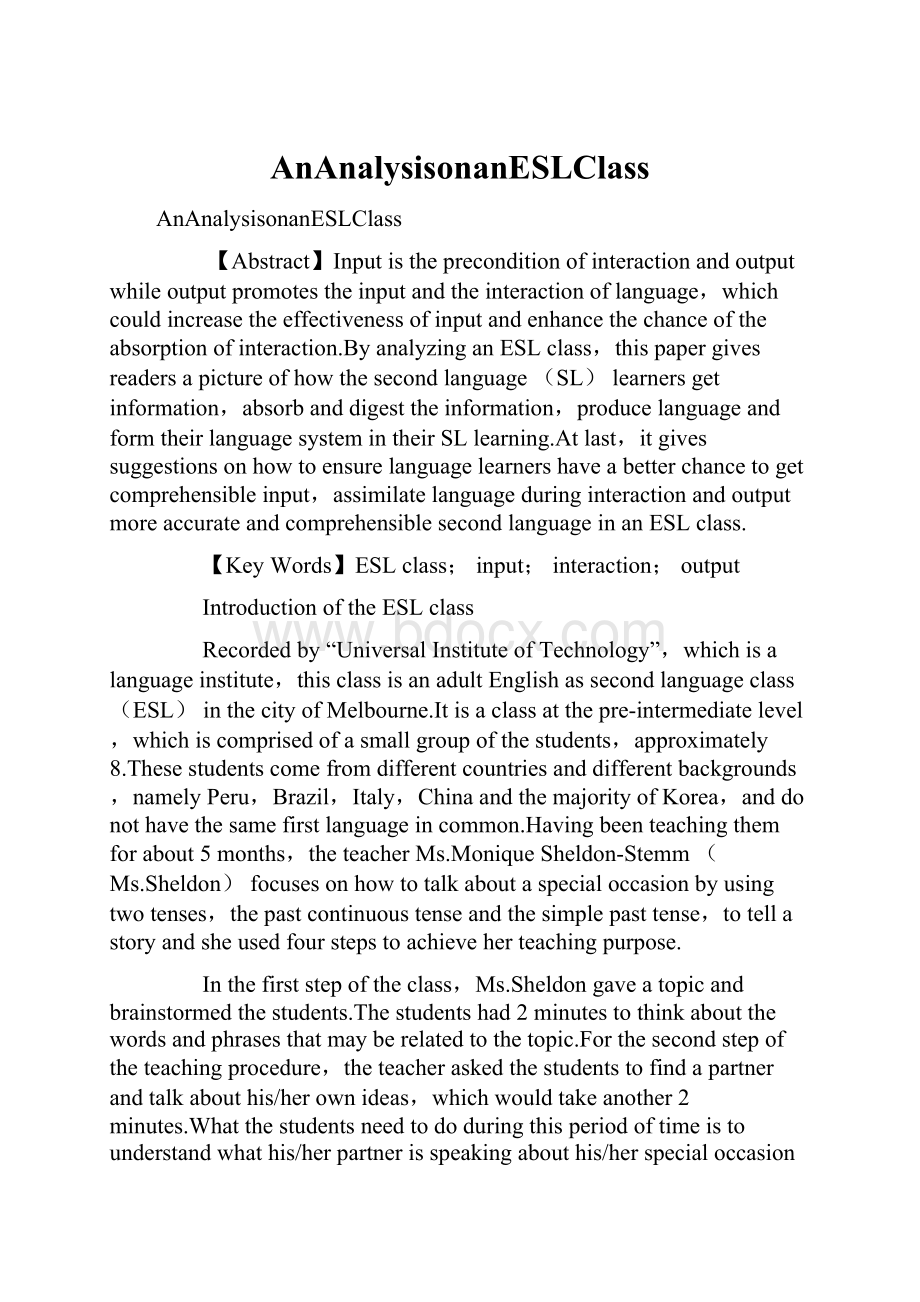AnAnalysisonanESLClass.docx
《AnAnalysisonanESLClass.docx》由会员分享,可在线阅读,更多相关《AnAnalysisonanESLClass.docx(7页珍藏版)》请在冰豆网上搜索。

AnAnalysisonanESLClass
AnAnalysisonanESLClass
【Abstract】Inputisthepreconditionofinteractionandoutputwhileoutputpromotestheinputandtheinteractionoflanguage,whichcouldincreasetheeffectivenessofinputandenhancethechanceoftheabsorptionofinteraction.ByanalyzinganESLclass,thispapergivesreadersapictureofhowthesecondlanguage(SL)learnersgetinformation,absorbanddigesttheinformation,producelanguageandformtheirlanguagesystemintheirSLlearning.Atlast,itgivessuggestionsonhowtoensurelanguagelearnershaveabetterchancetogetcomprehensibleinput,assimilatelanguageduringinteractionandoutputmoreaccurateandcomprehensiblesecondlanguageinanESLclass.
【KeyWords】ESLclass;input;interaction;output
IntroductionoftheESLclass
Recordedby“UniversalInstituteofTechnology”,whichisalanguageinstitute,thisclassisanadultEnglishassecondlanguageclass(ESL)inthecityofMelbourne.Itisaclassatthepre-intermediatelevel,whichiscomprisedofasmallgroupofthestudents,approximately8.Thesestudentscomefromdifferentcountriesanddifferentbackgrounds,namelyPeru,Brazil,Italy,ChinaandthemajorityofKorea,anddonothavethesamefirstlanguageincommon.Havingbeenteachingthemforabout5months,theteacherMs.MoniqueSheldon-Stemm(Ms.Sheldon)focusesonhowtotalkaboutaspecialoccasionbyusingtwotenses,thepastcontinuoustenseandthesimplepasttense,totellastoryandsheusedfourstepstoachieveherteachingpurpose.
Inthefirststepoftheclass,Ms.Sheldongaveatopicandbrainstormedthestudents.Thestudentshad2minutestothinkaboutthewordsandphrasesthatmayberelatedtothetopic.Forthesecondstepoftheteachingprocedure,theteacheraskedthestudentstofindapartnerandtalkabouthis/herownideas,whichwouldtakeanother2minutes.Whatthestudentsneedtododuringthisperiodoftimeistounderstandwhathis/herpartnerisspeakingabouthis/herspecialoccasionandtrytohelpeachotherandimprovebylisteningcarefully.Forthethirdstep,thestudentswereaskedtothinkabouthowtomakeapropersentenceandthenwritedown2sentencesusingtheirownwordsfrombrainstormingin5minutes.Ms.Sheldondidn’tforgettoremindthestudentsoftensestheyshoulduseformakingtheirsentences.Forstep4,shesuggestedthestudentschecktheirsentencesbyreadingaloudoraskingsomeoneelsesuchastheteacherorpartnerstofindwhetherthesentencesarecorrectornot.Thecriterionwasthatifthesentenceswereunderstood,theywerecorrect.Theneachstudentsneedtotelltheirstories,“ASpecialOccasion”totheirpartners.Ms.Sheldonemphasizedtheword“tell”,whichmeanswhenthestudentstelltheirstories,itisnotreadingbuthavingaconversationwithpartnersabouttheirparticularoccasions.Thenatlast,thestudentswouldsharethestorieswiththeclass. Fromtheconversationintheclassbetweentheteacherandthestudents,peoplecouldfindthattheteacheralwaysspokeinasoftvoiceandhelpedthestudentstocorrectsentencesandansweredtheirquestionscarefullyandpromptly.Shewassopatientwiththestudentsthatrepeatedtheinstructionsandquestionsagainandagaininordertoavoidmisunderstandingofthestudentsandputalotofemphasisofthestudents’feedbackinordertoensurewhethertheyunderstoodtherequirements.Everystudentwasaskedtoreadthe2sentencesthattheywroteloudlyandtoldtheirstoriestotheclass,whichmeantthateachhadtheopportunitiestopracticetheirlisteningandspeaking.
AnalysisoftheESLclass
Inthisclass,toachievethepurposeoftalkingaboutaspecialoccasionofthepast,Ms.Sheldonaskedeverystudenttobrainstormwordsandphrases,talkwithpartners,writedownsentencesandfinallytellandshareastoryofaspecialoccasionwiththeclasstopracticetheuseofthepastcontinuoustenseandthesimplepasttenseaswellastheEnglishskillssuchaslistening,speaking,readingandwriting.Inthisway,everystudenthastheopportunitytopracticeandimprovetheirsecondlanguage--English.Alsointheclass,guidedlearningandquestioningstrategieswereimplemented.Ms.Sheldonalwaysrepeatedtheinstructionsorquestionsandpaidmuchattentiononthefeedbackofthestudentsbyaskingthemwhethertheyunderstandthequestionsorrequirementsandguidedthemtoanswerherquestions,whicharousedstudents’noticingoflanguagelearning.Alsosheguidedthembysaying,“whowasthere?
Whenwasit?
Whathappened?
Wasitprivate?
Ataparty?
”etc.Howeverlargenumbersofrepeatedsentencesseemlikenotverypropertoteachadults.
Inaddition,inthisESLclass,theteacherstressedonthecooperationandmutualsupportamongthestudents,whichcreatedagoodlanguageenvironmentforSLlearnerstolearn,practiceanddeveloptheirsecondlanguagelearning.Besides,elementsoflanguagesuchaswords,sentencestructure,grammar,oralexpressionandessaywritingweretaughtfromstepbystep.Allofthemweretaughtinawayfromaneasyleveltoadifficultlevel.Asfarasweareknown,anessayiscomprisedofsentenceswhilesentencesarecomposedofwords.Theinformationoftheessayshouldbedeliveredbyoralexpressionlikepresentationorspeech.Readingthesentencesortheessayloudly,theinformationcontainedcouldbemeaningfulandunderstoodbyothers.Thusthefunctionoflanguage―transferringmeaningwillberealized. 1.Input
Inputreferstolanguagethatisavailabletothelearnerthroughanymedium(listening,reading,orgesturalinthecaseofsignlanguage).AlltheoriesofSLlearningrecognizethesignificantofinputasabasiccomponentinacquisitionprocess(Gass,Susan&Mackey,Alison2006).Thecomprehensiveinputhypothesisclaimsthattheacquirershouldunderstandinputlanguagethatcontainsstructureabitbeyondhisorhercurrentlevelofcompetence.Krashendefinedthelearner’scurrentstageofstudyinglanguageas“i”.Thenextstageofdevelopinglanguageis“i+1”(citedfromLiChao2013).Thatistosaythelanguagethatthelearnerslearnedshouldbealittlebitbeyondtheirpresentcompetence.Ifthelanguageiseithertoodifficultortooeasy,learnerscouldnotgetcomprehensibleinput.Becauseiftheinputlanguageormaterialistoodifficult,learnerscouldnotunderstandsothattheteachingprocedurecannotbekeptgoing,butiftheinputlanguageormaterialistooeasy,learnerscouldfeelthatthereisnochallengesothatloseinterestsandtheSLleaningcouldnotreceiveapleasantresult.
Intheclass,Ms.Sheldonaskedthestudentstousethepastcontinuoustenseandthesimplepasttense.Thestudentsabsolutelyhadlearnedthetwotensesbeforebuttheyneededtousetwotensestogetherintheirtasks.Itisakindof“i+1”inputbecausetheymightknowhowtousethemseparatelybutwhenmixedthem,theymightbeconfused.Whatismore,inthethirdsteptherewasastudentaskedwhetheritisonesentenceifthereiscommainthesentence.Theteacheransweredthattherecouldbemanycommasinonesentencebecauseinonesentencemanythingscouldhappenandthecommacouldgivethesentencedetails.Shealsotoldthestudentsthatasentencebeginswiththecapitalletterandendswithafullstopwithasentenceasanexample.ShegavethestudentseffectiveansweraccordingtotheircurrentlanguageabilitytohelpstudentstoacquirebetterunderstandingandcomprehensibleknowledgeduringSLlearning.
2.Interaction
Interactionisbelievedtobehelpfulinexchangesbetween/amonglearnersorbetween/amonglearnersandnativespeakers(orfluentspeakers)ofthelanguagebeinglearnedwherelanguageisnegotiated,orfeedbackisprovided.Feedbackisanimportantfeatureofinteractionandcanbeviewedonacontinuumbetweenexplicitandimplicit.Theinteractionhypothesisisprimarilyconcernedwithreactivefeedback―thatis,feedbackthatoccursasareactiontosomelinguisticproblem.Itcancomefrommanyindividuals,includingnotonlyteachers,butalsootherlearnersornativespeakersofalanguage(Gass,Susan&Mackey,Alison2006).Intheclass,Ms.SheldonisanativespeakerwhilethestudentsareSLlearners.DuringtheconversationbetweenMs.Sheldonandthestudents,peoplecanfindthattheteacher’slanguageinfluencedthestudents’andsomestudentsweretryingtocorrecttheirownlanguage.Alsointheteachingprocedure,theteacheralwaysfocusedonstudents’feedbackandrepeatedtherequirementsoraskedthequestionsagainandagaintoensurewhetherthestudentsunderstoodhertohelptheseSLlearnerstogetusedtoandimprovetheirSLlearning.Forexample,whensheaskedthestudentswhattheycoulddotohelpeachotherwhentheyweretalkingabouttheirideaswiththeirpartners,nooneansweredhersoshesaidthatshewasaskingaquestionandrepeateditagaintomakeherintentclearandunderstoodbythestudents.Inthisway,thestudentspaidmoreattentiontotheteacheraswellastheirSL. Theinteractionprovidesaforumforfeedback,whichservestoalertlearnerstoproblemsprovidingthenwithopportunitiestofocustheirattentiononlanguage.Thatis,interactionmayprimelearnersto“search”formoreinformation,tobemoresensitivetofutureinput(e.g.,usesofaword,structure,pronunciation,spelling),ortobemoreawareoftheirhypothesesaboutlanguage(Gass,Susan&Mackey,Alison2006).Intheclass,Ms.Sheldonandthestudentsdiscussedhowandwhybodylanguagehelpstheirexpression.Inourdailylifewecanalsorealizedthatpeoplealwaysusebodylanguagewhentheycannotexpressthemselvesclearly,especiallyamongthepeoplewhodonotspeakthesamefirstlanguage.Bydiscussingthis,studentscouldfocusontheirlanguageandgettheopportunitiestosearchmoreinformation